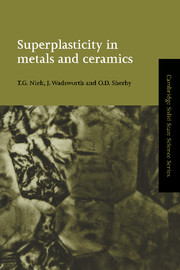Book contents
- Frontmatter
- Contents
- Preface
- Chapter 1 Introduction
- Chapter 2 Key historical contributions
- Chapter 3 Types of superplasticity
- Chapter 4 Mechanisms of high-temperature deformation and phenomenological relations for fine-structure superplasticity
- Chapter 5 Fine-structure superplastic metals
- Chapter 6 Fine-structure superplastic ceramics
- Chapter 7 Fine-structure superplastic intermetallics
- Chapter 8 Fine-structure superplastic composites and laminates
- Chapter 9 High-strain-rate superplasticity
- Chapter 10 Ductility and fracture in superplastic materials
- Chapter 11 Internal-stress superplasticity (ISS)
- Chapter 12 Other possible superplasticity mechanisms
- Chapter 13 Enhanced powder consolidation through superplastic flow
- Chapter 14 Superplastic forming and diffusion bonding
- Chapter 15 Commercial examples of superplastic products
- Index
Chapter 11 - Internal-stress superplasticity (ISS)
Published online by Cambridge University Press: 15 October 2009
- Frontmatter
- Contents
- Preface
- Chapter 1 Introduction
- Chapter 2 Key historical contributions
- Chapter 3 Types of superplasticity
- Chapter 4 Mechanisms of high-temperature deformation and phenomenological relations for fine-structure superplasticity
- Chapter 5 Fine-structure superplastic metals
- Chapter 6 Fine-structure superplastic ceramics
- Chapter 7 Fine-structure superplastic intermetallics
- Chapter 8 Fine-structure superplastic composites and laminates
- Chapter 9 High-strain-rate superplasticity
- Chapter 10 Ductility and fracture in superplastic materials
- Chapter 11 Internal-stress superplasticity (ISS)
- Chapter 12 Other possible superplasticity mechanisms
- Chapter 13 Enhanced powder consolidation through superplastic flow
- Chapter 14 Superplastic forming and diffusion bonding
- Chapter 15 Commercial examples of superplastic products
- Index
Summary
In addition to the fine-structure superplasticity (FSS) described in the previous chapters, there is another type of superplasticity known as internal-stress superplasticity (ISS). In these materials, in which internal stresses can be developed, considerable tensile plasticity can take place under the application of a low, externally applied stress. This is because internal-stress superplastic materials can have a strain-rate-sensitivity exponent as high as unity; i.e., they can exhibit ideal Newtonian viscous behavior. Such superplastic materials are believed to be deformed by a slip-creep mechanism.
There are many ways in which internal stresses can be generated. These include thermal cycling of composite materials, such as whisker- and particulate-reinforced composites, in which the constituents have different thermal expansion coefficients; thermal cycling of polycrystalline pure metals or single-phase alloys that have anisotropic thermal expansion coefficients; and thermal cycling through a phase change. In addition, pressureinduced phase changes have been cited as a possible source of superplastic flow in geological materials. For example, there is a phase transformation in the earth's upper mantle, because of pressure, from orthorhombic olivine to a spinel phase at a depth of about 400 km below the earth's surface. And it is believed that internal-stress superplasticity, arising from the transformation stresses through pressure cycling (analogous to temperature cycling), leads to a mixed-phase region of low effective viscosity.
- Type
- Chapter
- Information
- Superplasticity in Metals and Ceramics , pp. 208 - 218Publisher: Cambridge University PressPrint publication year: 1997



